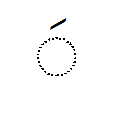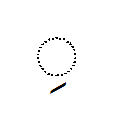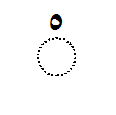Alfabet białoruski (arabski)
Arabski alfabet białoruski – alfabet wykształcony w XVI wieku na potrzeby Tatarów litewskich, którzy przejęli język ruski. Jako iż w podstawowym alfabecie arabskim brakowało niektórych liter, wykorzystano litery perskie lub utworzono nowe.

Np. dla głosek: ž, č i p (ж, ч i п) przyjęto znaki:
A dla głosek: dz i c (дз i ц) utworzono nowe znaki:
Dwa ostatnie znaki w standardzie Unikodu mają zajmować kolejno miejsca: U+08AE oraz U+08AF[1][2].
Wszystkie znaki w różnych alfabetach
Samogłoski
- (c) Korny78, CC-BY-SA-3.0Samogłoski A, E; na początku słowaاَ
- (c) Korny78, CC-BY-SA-3.0Samogłoski I, Y; na początku słowaاِ
- (c) Korny78, CC-BY-SA-3.0Samogłoski U, O; na początku słowaاُ
- (c) Korny78, CC-BY-SA-3.0
Brak samogłoski
Spółgłoski
Ligatura
| Cyrylica | Łacinka | Arabski | |||
|---|---|---|---|---|---|
| Formy kontekstowe | Izolowana | ||||
| Końcowa | Środkowa | Początkowa | |||
| Ла ла, Ля ля | Ła ła, La la | ـلا | لا | ||
Zobacz też
Przypisy
Bibliografia
- Д-р Я. Станкевіч. Беларускія мусульмане і беларуская літаратура арабскім пісьмом. [Адбітка з гадавіка Беларускага Навуковага Таварыства, кн. I.] – Вільня: Друкарня Я. Левіна, 1933 ; Менск: Беларускае коопэрацыйна-выдавецкае таварыства „Адраджэньне”, 1991 [факсімільн.]. – 3-е выд.
Media użyte na tej stronie
(c) Korny78, CC-BY-SA-3.0
The letter Damma from the Arabic alphabet, belonging to the group of Harakat diacritic marks, used to represent vowels. Damma sounds like a short /u/. The circle indicates the position of the consonant the Harakat is used upon.
(c) Korny78, CC-BY-SA-3.0
The letter Kasra from the Arabic alphabet, belonging to the group of Harakat diacritic marks, used to represent vowels. Kasra sounds like a short /i/. The circle indicates the position of the consonant the Harakat is used upon.
Autor: Maxime Seveleu-Dubrovnik, Licencja: CC BY-SA 3.0
Specific letter of the Belarusan Arabic alphabet: dal with three dots below
(c) Korny78, CC-BY-SA-3.0
The letter Sukun from the Arabic alphabet, belonging to the group of Harakat diacritic marks, used to represent vowels. Sukkun is used to indicate the absence of a vowel. The circle indicates the position of the consonant the Harakat is used upon.
(c) Korny78, CC-BY-SA-3.0
The letter Fatha from the Arabic alphabet, belonging to the group of Harakat diacritic marks, used to represent vowels. Fatha sounds like a short /a/. The circle indicates the position of the consonant the Harakat is used upon.
The letter Shadda from the Arabic alphabet, belonging to the group of Harakat diacritic marks, used to represent vowels. The shadda marks a long consonant. It is thus functionally equivalent to writing a consonant twice in most Latin writings. The circle indicates the position of the consonant the Harakat is used upon.
Autor: Maxime Seveleu-Dubrovnik, Licencja: CC BY-SA 3.0
Specific letter of the Belarusan Arabic alphabet: sad with three dots below












